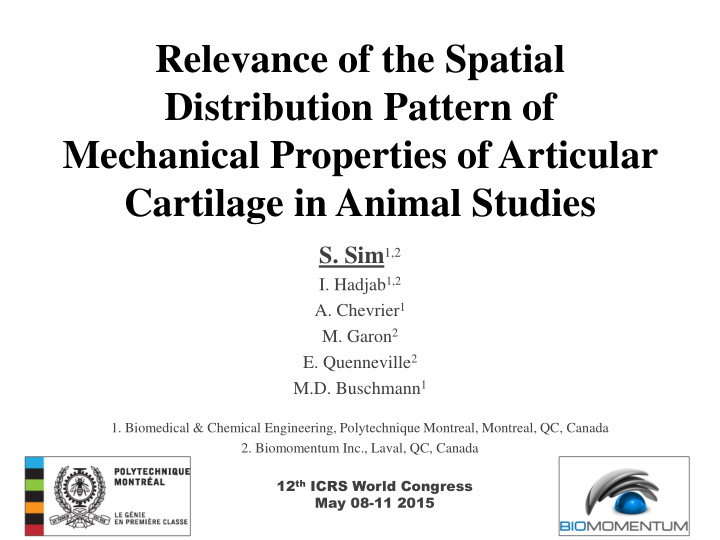



Relevance of the Spatial Distribution Pattern of Mechanical Properties of Articular Cartilage in Animal Studies S. Sim 1,2 I. Hadjab 1,2 A. Chevrier 1 M. Garon 2 E. Quenneville 2 M.D. Buschmann 1 1. Biomedical & Chemical Engineering, Polytechnique Montreal, Montreal, QC, Canada 2. Biomomentum Inc., Laval, QC, Canada 12 th ICRS World Congress May 08-11 2015
D isclosure Eric Quenneville and Martin Garon are the owners of Biomomentum Inc.
I ntroduction In order to evaluate the effect of cartilage treatment, appropriate control and treated sites need to be chosen. Treatment site Lateral Medial Control site However, finding the right location for the control and treated sites is quite challenging in articular surfaces where a natural spatial distribution of mechanical properties and thickness is present in all healthy joints (Setton et al., 1994; Räsänen et al., 1996 ).
I ntroduction Common mechanical test configurations impermeable Unconfined Compression impermeable Cartilage need to be harvested from the Non-destructive articular surface Allows for multiple Disruption of the articular surface and testing mechanical environment Allows for subsequent Difficult to properly extract cores from repaired analyses cartilage lesions in animals
I ntroduction The purpose of this study was to assess the importance of considering the spatial distribution of the mechanical properties of normal articular cartilage in animal models of cartilage repair, specifically the distributions of thickness and instantaneous modulus.
M ethods • Skeletally mature animals Sheep Rabbit n=3 n= 1 13-14 weeks 4-5 years • Right and left joints • Visually normal articular surfaces Tibial plateau Femoral condyles
M ethods Camera-registration system Mechanically-controlled surface mapping Sample Top view image (1280x960 pixels) Position grid superimposed Converts in units of length (mm) input Multiaxial Mechanical Tester
M ethods Mechanical testing by an automated indentation technique • 3-axis mechanical tester (Mach-1 v500css from Biomomentum) • Multiaxial load cell (force resolution: F z = 0.35 gf and F x = F y = 0.25 gf) • Spherical indenter (r = 0.5 mm)
M ethods Automated indentation technique Perpendicular Indentation at each position Contact coordinates (x,y,z) of Normal Thickness Surface orientation force/displacement vs predefined positions and 4 ( θ z ) is missing surrounding positions time
M ethods Automated indentation technique Perpendicular Indentation at each position Contact coordinates (x,y,z) of Normal Thickness Surface orientation force/displacement vs predefined positions and 4 ( θ z ) is missing surrounding positions time
M ethods Automated indentation technique Perpendicular Indentation at each position Contact coordinates (x,y,z) of Normal Thickness Surface orientation force/displacement vs predefined positions and 4 ( θ z ) is missing surrounding positions time
M ethods Automated indentation technique Perpendicular Indentation at each position Contact coordinates (x,y,z) of Normal Thickness Surface orientation force/displacement vs predefined positions and 4 ( θ z ) is missing surrounding positions time
M ethods Automated indentation technique Perpendicular Indentation at each position Contact coordinates (x,y,z) of Normal Thickness Surface orientation force/displacement vs predefined positions and 4 ( θ z ) is missing surrounding positions time
M ethods Automated Thickness measurement Replace the spherical indenter with a needle Vertical Cartilage Distance surface Subchondral bone Surface orientation Thickness = vertical distance x cosine (surface orientation)
M ethods Indentation analysis Perpendicular Force (N) Perpendicular Displacement (mm) Instantaneous Elastic Model Using the known in Indentation thickness Modulus (MPa) (Hayes, 1972) 𝐼 ∙ (1 − 𝑤 2 ) 𝐽𝑁 = 𝑄 2𝑏𝑙 (𝑏 ℎ ∙ 𝑤)
R esults Large variation within the medial and lateral compartment of femoral condyle and tibial plateau. The cartilage is thinner in regions covered by the meniscus while a thicker cartilage is observed on the rest of the surface.
R esults Large variation within the medial and lateral compartment of femoral condyle and tibial plateau. The cartilage is stiffer in regions covered by the meniscus while a softer cartilage is observed on the rest of the surface.
D iscussion Measured thickness agrees with those reported in the literature (Stockwell et al., 1971). The instantaneous modulus and thickness mappings measured show similar distribution patterns than those previously observed for the stifle joints of larger species, with stiffer and thinner cartilage in the region covered by the meniscus (Sim et al., 2013), suggesting a dependence with weight bearing and kinematics (Fukubayashi et al., 1980) for all species.
D iscussion Considering these results, major concern arise: Treatments may not be comparable if the chosen regions initially have different properties. Anterior 1.8 ± 0.3 MPa Lateral Medial 8.9 ± 4.0 MPa Posterior MPa
D iscussion Considering these results, major concern arise: Cartilage thickness and instantaneous modulus can vary by a factor up to 10 over a distance of only 5% of the total articular surface width. Lateral Medial MPa These thickness and modulus maps clearly show that any difference between treated and non-treated cartilage could be confounded with the natural topographic variability rather than due to the treatment itself.
C onclusion By considering the spatial distribution of cartilage properties when choosing control and treated sites, the effects of treatment may be more easily discerned.
A knowledgements Funding provided by the National Sciences and Engineering Research Council (NSERC) and the Fonds québécois de la recherche sur la nature et les technologies (FQRNT). Rat samples were provided by Simon Authier from CiToxLAB. Rabbit samples were provided by Anik Chevrier from the Biomaterials and Cartilage Laboratory (BCL).
R eferences Setton 1994, J Orthop Res 12:451 Räsänen 1996, J Biomed Mater Res 31:519 Jurvelin 1995, J Biomech 28: 231 Hayes 1972, J Biomech 5:541 Stockwell 1971, J Anat 3:411 Sim 2013, Trans ORS2013: poster 1975 Fukubayashi 1980, Acta Orthop Scand 51(6):871
O ther presentations • Correlation of Traditional and Novel Outcome Measures for the Assessment of Regenerated Osteochondral Tissue in a Sheep Model. Poster #83 • Evaluation of Entire Ovine Cartilage Repair Articular Surfaces: Mechanical and Electromechanical Assessment. Poster #87 • Correlation of Non-destructive Electromechanical Probe (Arthro-BST) Assessment with Histological Scores and Mechanical Properties in Human Tibial Plateau. Presentation #23.2.8 • Mapping Articular Cartilage Biomechanical Properties of Normal & Osteoarthritis Mice Using Indentation. Presentation #23.2.9
Recommend
More recommend